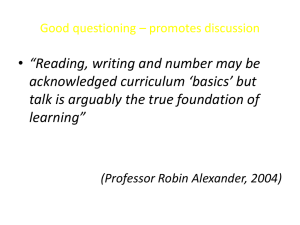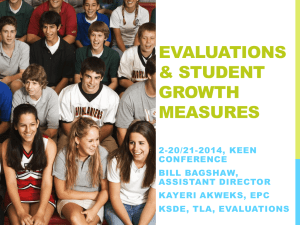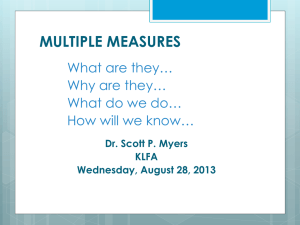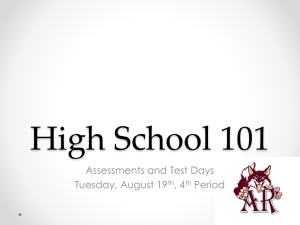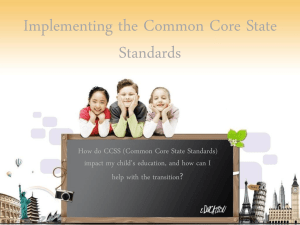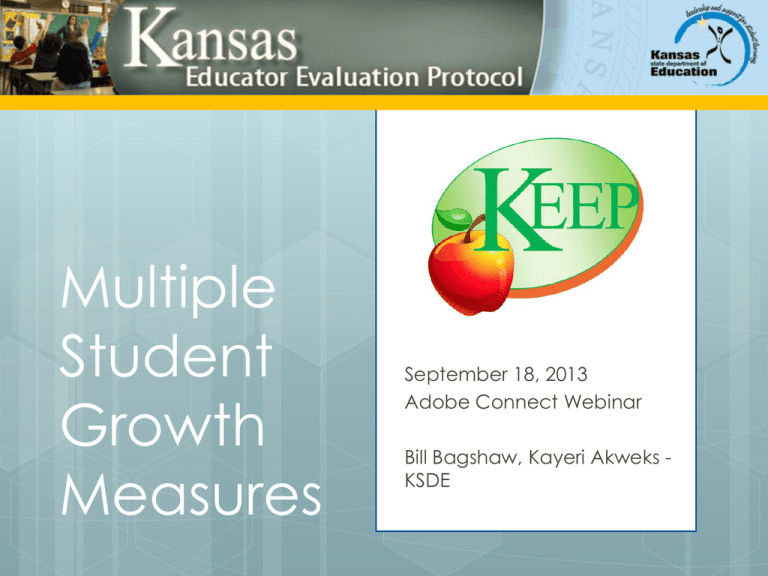
Multiple
Student
Growth
Measures
September 18, 2013
Adobe Connect Webinar
Bill Bagshaw, Kayeri Akweks KSDE
WAIVER - Principle 3
Supporting Effective
Instruction and
Leadership
Implement teacher and
principal evaluation and
support systems that:
Are used for continual
improvement of instruction
Use at least 3 performance levels
Use multiple measures including
student growth as significant
factor
Are used to evaluate on a regular
basis
Provide clear, timely, and useful
feedback
Are used to inform personnel
decisions
Multiple Measures
Measures to Use
State assessments must
be used
Include assessment
measures currently in use
in your district
Shared
credit/responsibility for
student growth subject
to local decision making
Time for student growth
1-4 years
Sample Measures by KSDE from the Field
Academic Measures –
State Assessments
• History and
Government State
Assessment
• ESOL State
Assessment
• Reading State
Assessment
• Mathematics
State Assessment
• Science State
Assessment
• Writing State
Assessment
Academic Measures –
Not State Assessments
Common Academic
Assessments
• ACT/SAT scores
• Aimsweb
• AP scores
• CETE Formative Assessments
• DIBELS
• District wide Common
Assessments
• Fitness Grams
• Lexile Scores
• Measures of Academic
Progress (MAP)
Other Academic Assessments
• Student constructed
response with rubric for
assessment
• KWIET portfolio
• Performance based
measures
• Project Rubrics
Other Student Knowledge and Skills
Measures
College and Career Ready
Measures
• Industrial Certifications
assessments (Technical Skills)
• Interpersonal communication
skills (Interpersonal Qualities)
• WorkKeys (Career Interest
Development)
Other Non Academic Measures
• Sportsmanship rubric
• Life skills (nutrition, physical
activity)
• Occupational therapy skills
• 21st century skills
• Library usage (using library tools
to find resources)
Multiple Measures
Student Growth Measures
Webpage
http://www.ksde.org/Defa
ult.aspx?tabid=5798
Matrix for Summative
Evaluations Rating 8-2013
Default List of Multiple
Measures DRAFT September 2013.docx
Multiple Measures
Student Growth Measures
Webpage
Significant is defined as showing student growth in multiple ways.
Kansas educators have long used measures to indicate levels of
student growth. Some assessment measures are purchased
because they are deemed valid and reliable and are intended to
depict a specific knowledge or skill demonstrated by the student.
Other used measures are referred to as common assessments or
local assessments. These tend to be locally or regionally created.
The difficulty in deciding which measures are appropriate (valid
and reliable) has resulted in the need to develop a Kansas “default
list” of measures that educators may use at any given grade level
or in any given content area.
The KSDE is facilitating the development of the default list with the
help and input of Kansas educators, REL and the Center for Great
Teachers and Leaders. The developed list will appear on the KEEP
webpage.
Multiple Measures
Student Growth Measures
Webpage
Districts wanting to use measures of student growth not on the list will have a
process to analyze the validity and reliability of the desired measure once the
measure has been approved for meeting the criteria of acceptable technical
quality. Some of the expected criteria are, but not limited to:
Common assessments must be created in consultation with a school
administrator with expertise in assessments, special education, ELL specialist and
content expert.
Assessments cover all key subject/grade level content standards.
Number of test items should correlate to distribution of % of time spent teaching
the content
Assessments should require higher order thinking as appropriate.
Assessments should allow high and low achieving students to demonstrate their
knowledge.
Assessments should measure accurately what it is designed to measure and
produce similar results for students with similar levels of ability.
State assessments must be used as one of the multiple measures selected for
those grade levels and content areas where assessments are given.
All Kansas school districts will provide continual professional learning opportunities
for building leaders with a primary focus of district level training with regard to
inter-rater reliability as part of the evaluation process.
8
Multiple Measures
State Assessments from 2008 to
the present
KSDE has retroactively
calculated
student growth percentiles
Multiple
Measures
for all students from Kansas state assessments from 2008
through the present (four years of data).
An interim assessment will be given during the 2013-2014
academic year.
A formula has been developed to compare the interim
assessment scores to the 2008-2012 state assessment data.
Inferences will be made between existing data (2008-2012)
and the interim data (2014). This process will be ongoing with
each year of accumulated data from the eventual Kansas
State Assessments, thereby accruing longitudinal data from
2014-2017.
Multiple Measures
In addition to Kansas State
Assessments:
•
Educators will use at least two
other valid and reliable student
growth measures to determine
student growth - to be used in
the educator evaluation as a
significant factor.
•
Student growth measures will
have varied student
achievement expectations due
to the intent of the measure
itself and student grade level or
ability level.
•
Student expectations for
achievement on any given
measure will be predetermined.
Multiple Measures
Assessments that
Measure More than just Academic
Preparation
We are also looking at
assessments that measure
more than academic
preparedness, such as:
21st Century Skills
Critical Thinking
Employability
Technical Skills
SBoE has previously
approved the College and
Career Ready definition.
Co-Construct
Builder Leaders and
Teachers Co-Construct
the Educator Evaluation
Multiple Measures
Locally Determined Selections –
from default list or KSDE other
approved measures
Validation – REL, KSDE content
area specialists, or LEA able to
meet valid and reliable criteria
Significant Student Growth
Determining significance
– Matrix, Other Examples
Establishing timeline for growth
– Student Growth Percentile
Multiple Measures and
Significance Summary
Teachers and Leaders evaluations
include multiple measures as evidence
Kansas is defining “significance” as
demonstrating student growth using
MORE than one measure
Must consider state assessments
May include assessment measures
currently in use in your district
Validity of the Measure must be predetermined for any appropriate
measure
Locally determine credit/responsibility
for student growth
Time for student growth 1-4 years
Define Significance
TASP
TASP – Teacher Access to Student
Performance (in process)
As part of the longitudinal data collections, student performance
data is being linked to licensed building personnel participating in
Pilot II and III.
A student-course data collection system that links individual
students to each of their courses and teachers is being built.
During 2013-2014, KSDE begins the process of analyzing the
accumulated data for each of the following:
Examining the quality of the linked student-course-teacher
data submitted by schools and districts;
Identifying, planning, and making needed improvements to
the data quality;
Merging the student growth data with linked student-courseteacher data; and,
Testing analytic methods for summarizing students-by-teacher
performance.
Waiver 2013-2014
Deliverables:
1.
2.
3.
4.
5.
6.
7.
8.
Deliverables
Complete Kansas state default list of Multiple Student Growth Measures
Complete Kansas Department of Education Summative Evaluation
Rating Matrix
Provide technical assistance around the identification and use of
multiple measures from the default list
Provide technical assistance on defining significance within each of
the multiple measures
Provide training to LEAs on the use of the REL developed rubric for the
validation of new multiple measures
Each district using an evaluation system other than KEEP will provide
documentation to KSDE demonstrating how the evaluation instrument
meets the third guideline of student growth as a significant factor
A protocol will be developed to validate locally developed methods of
determining significance
Develop and provide technical assistance focusing on inter-related
reliability
KEEP Guided Practice
NEW !! KEEP Guided Practice
http://training.ksde.org/keep/
trainingportal/web/index.htm
New Online Training – open
24/7
Individualized and
Repeatable
Includes multiple forms of
Learning
Available from links on the
KEEP Webpage
Must have JAVA enabled
KEEP Webpage
http://www.ksde.org/Default.aspx?tabid=4400
1.
2.
3.
4.
5.
6.
News and Announcements
KEEP Repository Registration
KEEP Training Materials and Schedule
Archives with Materials of Previous
Trainings and Meetings
Assurances Information
Kansas Flexibility Waiver Materials
Questions ??
Contacts:
Bill Bagshaw,
Assistant Director
Teacher Licensure
& Accreditation
bbagshaw@ksde.org
785.296.2198
Kayeri Akweks,
Education Program Consultant
Teacher Education and Licensure
kakweks@ksde.org
785.296.5140
An Equal Employment/Educational Opportunity Agency
The Kansas State Department of Education does not discriminate on the
basis of race, color, national origin, sex, disability, or age in its programs
and activities. The following person has been designated to handle
inquiries regarding the non-discrimination policies:
KSDE General Counsel, 120 SE 10th Ave., Topeka, KS 66612; 785-296-3201



